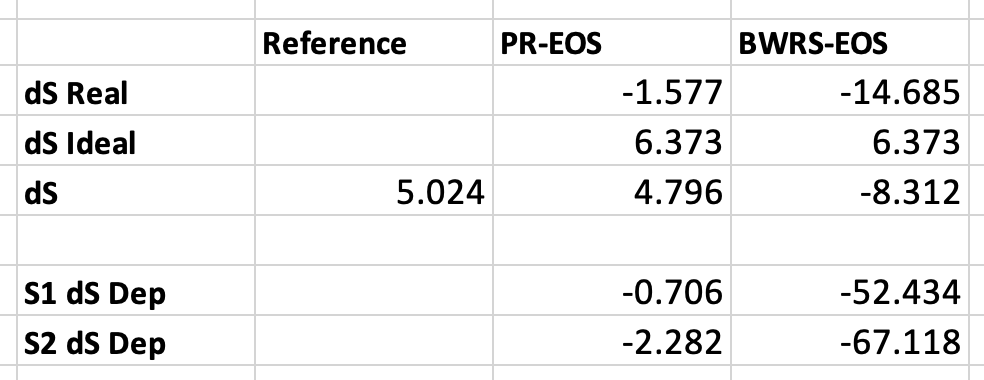Edit: This was not a homework problem. I simply pulled an example from a textbook to easily illustrate and convey the problem at hand.
I am seeking some assistance in evaluating the entropy change of a real gas using BWRS-EOS. I have successfully accomplished this using Peng-Robinsons which will be used as a point for comparison. Any feedback or suggestions would be highly appreciated. Consider Example 8.8. Enthalpy and entropy from the Peng-Robinson equation - Introductory Chemical Engineering Thermodynamics by J. Richard Elliott.
As evaluated via BWRS-EOS for Propane - Python script: https://pastebin.com/80w9npaT
T1 = 378.15 K, P1 = 500 kPaA, Enthalpy Departure = -407.06 J/mol, Entropy Departure = -52.43 J/mol, Cp Ideal = 89.82 J/mol.K
T2 = 463.15 K, P2 = 2500 kPaA, Enthalpy Departure = -1324.7 J/mol, Entropy Departure = -67.12 J/mol, Cp Ideal = 105.04 J/mol.K
$\Delta H = \Delta H_{ideal} + \Delta H_{real} = C_p * (T2 - T1) + (\Delta H_{departure2} - \Delta H_{departure1})$
enthalpy_delta = 0.5*(89.82+105.04)*(463.15-378.15) + (-1324.7-(-407.06)) = 7363.91 J/mol CORRECT
$\Delta S = \Delta S_{ideal} + \Delta S_{real} = C_p * ln(\frac{T2}{T1})-R*ln(\frac{P2}{P1}) + (\Delta S_{departure2} - \Delta S_{departure1})$
entropy_delta = 0.5*(89.82+105.04)*ln(463.15/378.15) - 8.31447 * ln(2500/500) + (-67.12-(-52.43)) = -8.32 J/mol.K. INCORRECT
The results for enthalpy are correct, however, entropy is horribly incorrect. I strongly believe this is due to the entropy departure values which differ from what I calculate via Peng-Robinson by over 1000%. As summarised in the comparison between PR-EOS and BWRS-EOS below, the entropy departure as calculated by BWRS is an order of magnitude larger than PR-EOS.
Any advice would be highly appreciated, I've been struggling for a while and cannot get this to work.
Entropy departure per K.E Starling:



